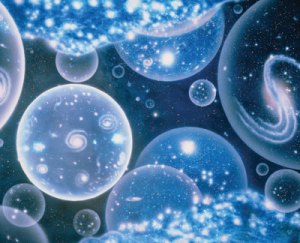I read Leonard Susskind’s book about the Anthropic Principle both before and after reading The Beginning of Infinity. In fact, it was one of the driving forces behind my choice of Deutsch’s book. Susskind’s description of the problems associated with an infinite multiverse (Susskind calls it a megaverse instead) was another reason for me to doubt that infinity could exist. Deutsch convinced me, though, that if infinity appears in our best explanations, then it must be real. And the reality of infinity is a big problem for Susskind’s Anthropic idea.
Susskind bases his main argument on four ideas. Two are from theoretical physics, two are from observational cosmology.
1) Eternal inflation demands that the world be a megaverse, with pocket universes that bubble up out of inflating space.
2) String theory defines not just one unique set of universal laws, but rather an enormous 10500 such sets of laws (maybe more). Such a huge landscape virtually ensures that one (or more than one) will have the right set of laws and constants to make our existence possible.
Combine these two and you see that if each of the universes in the megaverse has a randomly-selected set of laws and constants, then one of those pocket universes will be ours.
3) Measurements on the cosmic microwave background indicates that inflation really did happen, making the megaverse much more probable.
4) Most crucially for Susskind’s argument is the discovery of the non-zero cosmological constant (dark energy). According to Susskind, the only “explanation” for this incredibly small yet non-zero quantity is the Anthropic Principle.
I found it all to be a compelling argument before I read Deutsch. I still find it compelling after reading Deutsch, with the caveat (that Susskind himself covers fully in his book) that the measure problem is a big one.
First, there is excellent evidence that inflation actually occurred. The cosmic background radiation is still under active study, but the idea of inflation has survived all the CMB tests so far, when it could easily have failed any one of them. That’s impressive.
Second, no one seems to see a way for cosmic inflation to produce anything but a huge number, in fact an infinite number, of pocket universes.
Third, string theory is pointing toward a reality in which our laws of physics are arbitrary, the result of a contingent accident that happened in our particular pocket universe. In any other pocket universe, the compactification of extra dimensions and the collection of stuff found in those dimensions would almost certainly lead to a very different universe, almost certainly one with laws of physics completely hostile to life.
Fourth, while we don’t yet know what combination of canceling particles leads to such a tiny but non-zero cosmological constant, it seems pretty certain that it is a result of this contingent accident – because the contant is to high precision exactly what it would need to be for us to be here.
The problem is the not just large number, but infinitely large number of universes that seem to come from inflation. With a very large number of universes, we’re still in good shape in applying the Anthropic Principle as a guide. But with an infinite number of universes, probabilities become meaningless. What does it mean to say that our universe is rare if there are an infinite number just like it? And another infinite number just like it except for one tiny difference? And another . . . you get the point.
Susskind gets it, too, and spends some time reflecting on the past. The ultraviolet catastrophe was a case in which theory predicted an infinity. Planck developed the idea of the quantum to get around it. Later, on, quantum electrodynamics was plagued by infinities until Feynman and others developed renormalization techniques that made the infinities go away. So perhaps, Susskind postulates, the idea of infinite numbers of pocket universes will go away, too, with further research.
The other point I recognize from Deutsch is that of course the Anthropic Principle is really just a guide. It might well play a part in the final explanation, but it cannot be the whole explanation. Something makes the cosmological constant so incredibly tiny and yet non-zero. That something, to have so much possible variability, must be enormously complex. It reminds me a little bit of the discovery of the periodic table. The fact that the elements had such diversity should have been a clue that there was structure in there. The discovery that the diversity had patterns seems to be about where we are now in string theory. What do the patterns mean? That comes next.
The most exciting thing about this whole subject is that even the top scientists in the field recognize how utterly far away we are from knowing the answer. And yet, as I learned from Deutsch, the answer is out there. Problems are soluble. I can’t wait to learn more.


1 comment
Comments feed for this article
February 10, 2012 at 12:05 pm
A Universe From Nothing « Turtle Universe
[…] And yet, when virtual particles are included in the calculations of empty space, the result is wrong by 120 orders of magnitude, making this the worst prediction in the history of science (the same terrible prediction Leonard Susskind discussed in The Cosmic Landscape.) […]